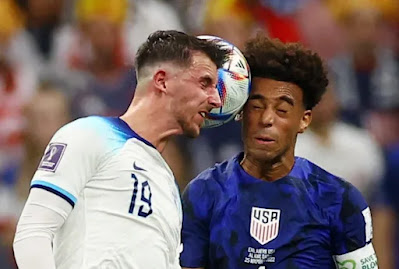One of several delusions that seems to be afflicting our Yankee fan brethren—could this be a late Covid thing?—is that without Aaron Judge and his salary clogging the roster, Brian Cashman could set about brilliantly moulding a champion.
They often throw in the suggestion that Cooperstown Cashman not only let Judge walk, but also dispose of Giancarlo Stanton, Gerrit Cole, and others in the bargain.
This is, first, mostly magical thinking. The many, many passed-up opportunities to sign great free agents or trade for others are not going to suddenly reappear just because Aaron Judge is playing in California. For that matter, there is no way that HAL is going to simply swallow huge portions of the bloated contracts handed out to the team's outstanding weightlifter or its demi-ace—provided that either could be forced or persuaded to go at all.
But I'd also like to say to these zanies and fools...you expect WHO to rebuild the team?
Let us go back, back to December 11, 1975. The day that marked the start of the last great—and maybe the one and only—counterintuitive rebuilding of the New York Yankees.
With George Steinbrenner still officially suspended from baseball (for the first time), the GM he'd brought
in from Cleveland, Gabe Paul, pulled off a fabulous coup.
Few people saw Gabe Paul coming. A rather battered baseball lifer, he'd never gone very far with any team.
But two months before joining the group Old George put together to buy the Yankees, "the Smiling Cobra," as Paul was called, had just happened to deal Graig Nettles to the Bronx.
In 1974, he acquired Chris Chambliss and Dirt Tidrow from his old team as well, and filched Lou Piniella from the Royals for Lindy McDaniel. And now, after a disappointing, injury-ridden 1975 season, the Smiling Cobra was ready to strike again.
On the same day, Paul traded Yankees centerfielder Bobby Bonds to the Angels for Ed Figueroa and Mickey Rivers—and starter Doc Medich to the Pirates for Dock Ellis, Ken Brett, and rookie second baseman Willie Randolph.
(It was believed to be the very first Doc-for-Dock deal in baseball history.)
It was also believed to be a terrible trade. Bonds was an outstanding, "five-tool" outfielder, who had uncomplainingly played most of 1975 in center despite a bad leg. He was, at the time, only the third 30-30 player
ever, a feat he had repeated for the Yankees.
Sure, he struck out a lot (for the time, not by today's standards), but he was also a three-time Gold Glove winner and only 29 years old. Trade him for a starter like Figueroa, who had gone all of 18-21 in his short career? And a weird, bandy-legged base stealer like Mickey Rivers, a speed player who didn't get walks?
For that matter, Medich was only 26, but already a horse as the No. 2 guy in the Yanks' rotation, having won 49 games over the last three years. Trade him for a journeyman middle reliever like Brett, a rookie infielder who the Pirates thought would never dislodge Rennie Stennett—and the ever-grousing Dock Ellis, who boasted about throwing a no-hitter while on acid?
Yet it was only part of Gabe Paul's complete Yankee makeover.
Another 1975 starter, Pat Dobson, had already been dealt away for another Clevelander, outfielder Oscar Gamble. Ken Brett was soon flipped, with back-up outfielder Rich Coggins, to the White Sox for Carlos May.
Once the season was underway, Paul kept dealing. He shipped yet another starter, Larry Gura, to the Royals for Fran Healy. Then, in a trade deadline blockbuster, he sent Rudy May, Tippy Martinez, Scott McGregor, Rick Dempsey, and Dave Pagan to the Orioles, in exchange for Doyle Alexander, Ken Holtzman, Grant Jackson, Hot Rod Hendricks, and Jimmy Freeman.
He even picked up Vida Blue, basically for cash—only to have the deal nixed by the commissioner, on the grounds that there's no money in baseball, or some such.
By the time he was through, Paul had dealt away four-fifths of the Yankees' 1975 starting rotation, in Medich, May, Gura, and Dobson. It seemed like an astonishing gamble.
And not all of what he did proved to be so great. Gura won 111 games in Kansas City—but Paul had little choice, Billy Martin loathing the pitcher because...Gura played tennis, which Martin considered proof of his lack of manliness. But while just a chronically injured, third-string catcher, Healy—whose clubhouse nickname was "Kissinger" played an invaluable role in keeping Reggie on the team and playing the next couple years.
The Orioles trade was also a bad one—in the long run. But Alexander had a terrific half-year in New York as a starter and Jackson was invaluable out of the pen (and Rudy May, at least, found his way back to the Yanks by 1980, to lead the AL in ERA).
And the big two deals...
Yes, Bobby Bonds was a star—almost a superstar—and he would have more excellent seasons. But Figueroa would win 62 games with the Yanks, become the first Puerto Rican pitcher to win 20 in a season, and take two rings. Mickey Rivers proved to be—somehow—an invaluable catalyst on those same Yankees teams.
Dock Ellis won 17 games in 1976, before being pedled off in 1977 to bring in Mike Torrez. And Willie Randolph...well, what can't you say about Willie Randolph?
Paul had put together a team that was perfect for the "Billyball" style his manager liked to play, and the Yanks swept to the pennant in 1976. He had also laid the foundation for the powerhouse that would win it all in 1977 and 1978, and make it back to the World Series in 1981.
Think Brian Cashman can do that?





































